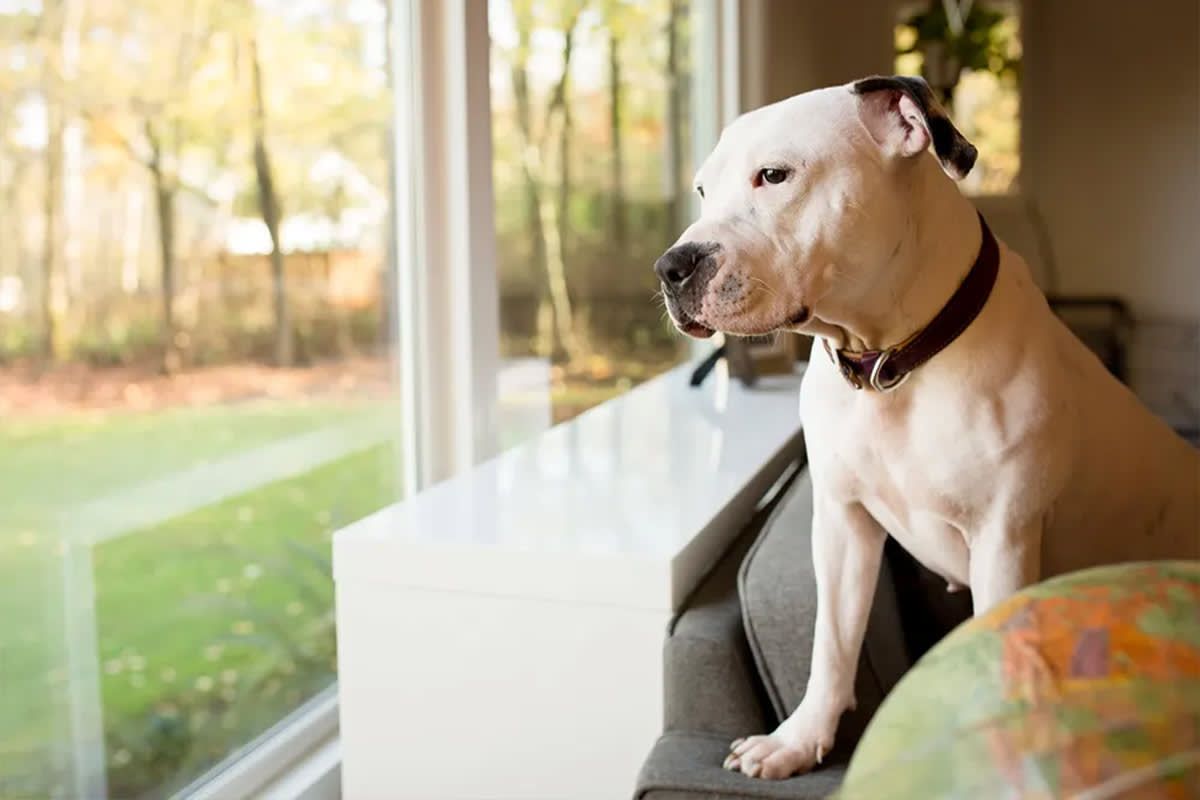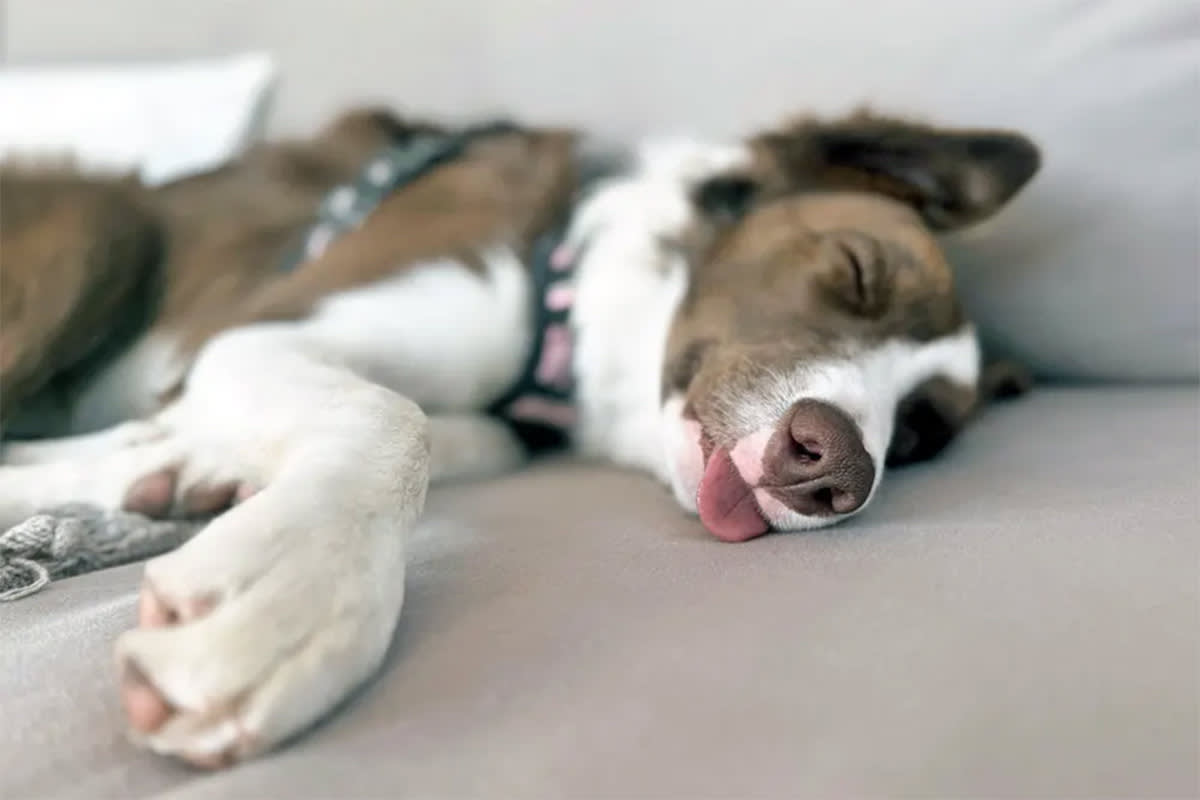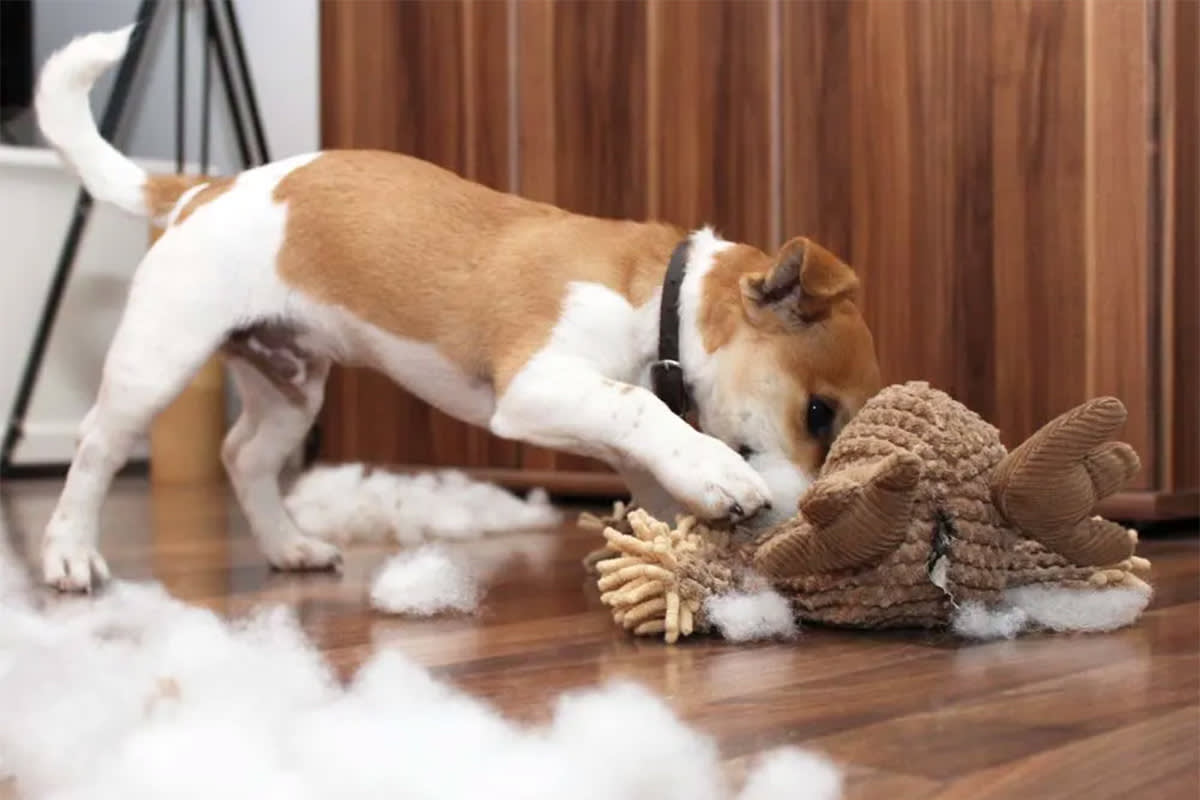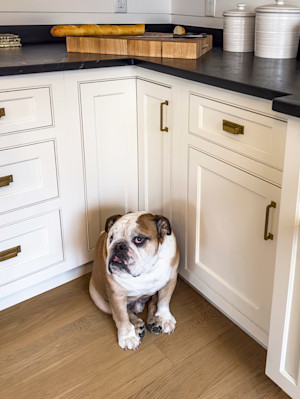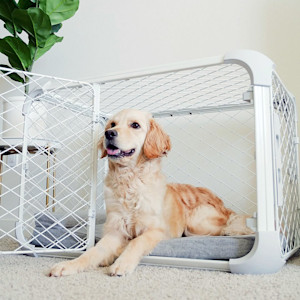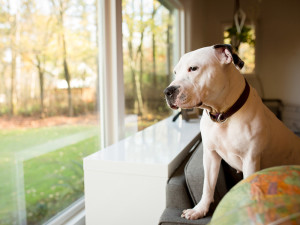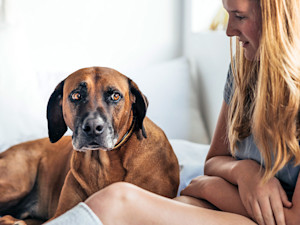8 Things Our Dogs Are Really Doing While We’re Away
Is it like The Secret Life of Pets, or what?
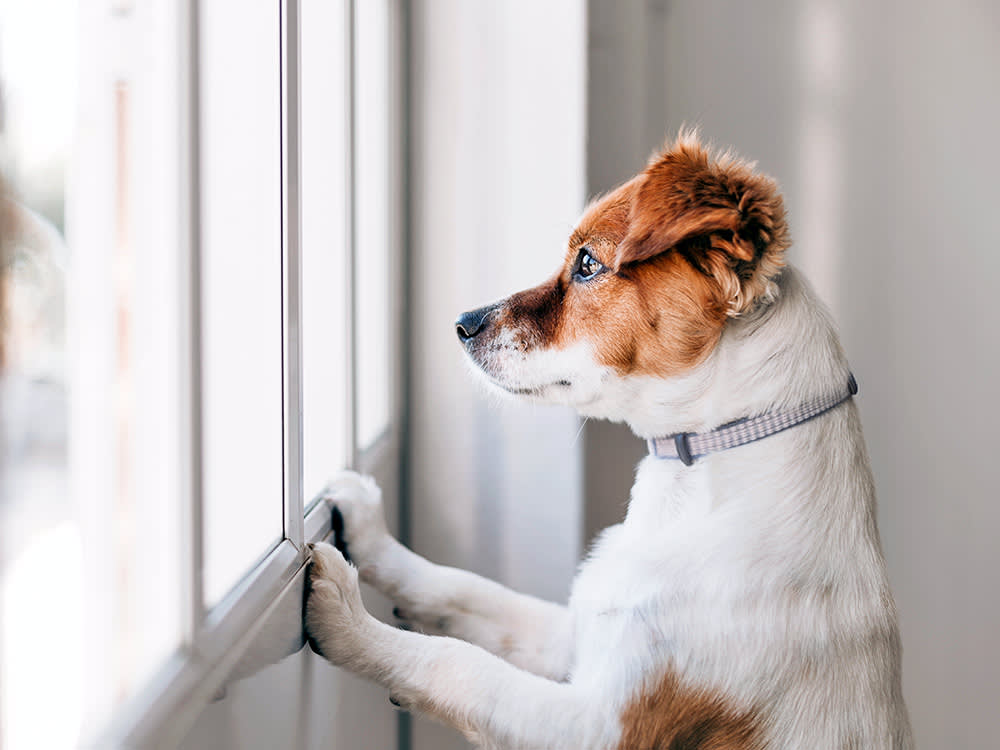
Share Article
Do you ever lock eyes with your dog on the way out the door and realize that for the next few hours, they’re going to be totally alone? Every time I catch my beloved pooches’ eyes as I leave for an errand, the inevitable question comes to mind: What will they do while I’m away?
We all want to make sure our pets are happy at all times, so it’s natural to wonder how they cope with our absence. The answer, of course, depends on the dog.
“Dogs are just as unique as people,” says certified professional dog trainer Johnna Biondi — owner of Dogs by Johnna Incopens in new tab. “While many dogs have a favorite spot where they nap throughout the day, others prefer to keep watch over their surroundings, especially if they have a view of the street.”
Other behaviors run the gamut. The real question for us humans often comes down to the emotional context underneath. For instance: Some dogs like to birdwatch out the window for fun, but others do it out of fear (like, is that bird going to come into their house?). Curious what your dog’s home-alone behavior says about their emotional state?

Let’s get into the most common canine hobbies — and which ones could signal a problem.
What do dogs do when they’re alone?
They wait for you to come back.
If your dog sits right by the door as you leave and hasn’t moved an inch by the time you get back, it’s not necessarily a sign of separation anxiety. Strange as it might sound, they might just be that excited for your grand entrance.
Certified separation anxiety trainer Beverly Lassiter has this conversation all the time with clients. “Your dog could choose to follow you everywhere you go in the house and wait for you by the door,” she says. That doesn’t automatically mean they have separation anxiety.
As for how to spot the difference between anxiety and plain old excitement, it all comes down (as so many things do) to body language. “The research says that there are just some dogs who follow people around,” Lassiter says. “Those dogs don’t necessarily have separation issues. They are able to relax. They can do all of that relaxation right there by the door. They just want to be informed when you come back in.”
If your dog feels calm in waiting mode, you’ll see it in their posture, facial expressions, and vocalizations.
A relaxed dog will have:
Loose, easy posture
Floppy ears
Soft eyes
A nervous dog, on the other hand, could show you:
Stiff posture and clenched muscles
Pricked or pinned-back ears
Panting or drooling
Even if your dog sits by the door for a few hours while you’re away, as long as they seem comfortable, Lassiter says they’re doing just fine. Anxious dogs, on the other hand, might also pace, bark, or, as many an unfortunate pet parent knows, destroy the furniture. If you notice any of these behaviors, scroll down for tips to help with potential separation anxiety.
They monitor the outside world from your window.
Just like humans, some dogs develop a passion for snooping on their neighbors. And as with most activities in this list, what that means depends on their attitude.
Lassiter recalls a specific dog who loved sitting on the back of her parents’ couch to watch the birds and squirrels outside while her parents were away. “That activity was very relaxing for her,” Lassiter says. “You could see that by the fact that she would sort of go in and out of wake and sleep cycles, just right there [on the sofa].”
Other dogs, though? “They’ll see the squirrel, and they'll never be able to calm back down.”
Some dogs know how to self soothe, but others need some help from us — or some training — to learn how to come down from excitement. “With separation behaviors,” Lassiter says, “what we look at is, can they learn to do that on their own or with training?”
If your dog seems happily curious about the goings-on of your neighborhood, be sure to ask them what they saw while you were away. You never know what those birds and rodents might be up to.
They pace around the living room.
It’s normal for a dog to wander around the house while we’re away, especially if they’re grabbing a snack or looking for a favorite toy. But if your dog seems to restlessly pace around for long periods of time while you’re gone, it could be a sign that they’re struggling.
They take a nap.
Ideally, sometime in between watching the birds and having a sip of water, your dog will take a little snooze. Most of the time, this means they’ve reached the realm of ultimate chill.
There is, however, one exception. If your dog falls asleep only after frantically pacing and barking at the door or trying to escape a crate, they are not relaxed; they’ve just tuckered themselves out after a prolonged period of panic.
“Some dogs do fine crated,” Lassiter says, “but often, with dogs with separation issues, we crate them because we're worried that they're going to be destructive if we don’t.” As with many of the other signs, then, the difference is how your dog acts before and after falling asleep.
They hatch an escape plan.
This one is rare but worth remembering — especially for those who leave their dogs with access to a backyard.
Biondi recalls a story she once heard about a Black Lab who lived in a lakefront home in California. “When his owners left, he’d wait until they were gone, then jump into the lake and swim to a neighbor’s house to play with their dog,” she says. “He was clever enough to recognize the sound of his parents’ car and would swim back just in time before they pulled into the garage.”
Without specific precautions, there’s always a chance that dogs left outside unsupervised might find a way out. Bad weather, fireworks, and other unpleasant environmental factors could cause them to panic and behave differently from how they normally do. Always exercise caution, and when in doubt, talk to your vet or trainer to make sure your dog is safe at all times.
They have a snack.
This one could be good or bad, depending on what your dog chooses to snack on. Designated food, water, and treats are good. Rotting garbage fished out of the trash can? Not so much.
If your dog tends to binge on inappropriate (non-toxic) goodies while you’re away, prevention could be key. Secure all trash and make sure anything your dog might want to covertly nibble on is kept out of reach. Another thing to watch for: Dogs who won’t eat or drink while we’re away. According to Lassiter, this is a common sign that your dog might feel uncomfortable being alone.
They play with toys.
A busy dog is a happy dog. If your dog is a fan of toys, it never hurts to leave a few out to keep them preoccupied while you’re gone.
“Dogs have preferences about the type of toys they enjoy and their favorite activities to do with that toy,” Lassiter says. “Pay attention and note which ones your dog loves and provide access to those (as long as the toys are safe to play with when you aren’t there).”
If your dog has separation issues, a toy that dispenses treats could help keep them occupied and provide the dopamine rush of a little snack. “For my food-loving dogs, I like balls they can push aroundopens in new tab and treats or kibble falls out,” Lassiter says, “but only if they don’t try to rip up the toy.”
More destructive dogs might prefer durable Kongsopens in new tab or Toppl toysopens in new tab. Dogs who just want someone to cuddle, meanwhile, could prefer a stuffed toy. And if you have a puppy who loves to chew, consider leaving them a chew stick holderopens in new tab for a parent-approved way to scratch the itch.
Whatever your dog’s preference, Lassiter emphasizes safety above all else: “Always observe your dog’s behavior with toys before leaving them alone with them.” Never leave them home alone with a toy that could be a choking hazard, like a rope toy, or anything you are afraid they will ingest.
They “play” with furniture.
Some dogs might roll their eyes and call this one a nasty stereotype, but we all probably know at least one dog that tends to destroy furniture or chew on forbidden items when their parents are away. But would you believe that not all dogs do this out of anxiety?
Let’s call it Kevin McCallisteropens in new tab Syndrome: When parents are away, the kids will play — in all of the ways that are normally forbidden.
“Some naughty, not-anxious behaviors can be things like touching things that they’re not allowed to touch when you're there,” Lassiter says. “It can be jumping up onto counters or tables. It can be getting the remote that they’re not allowed to chew on and chewing on that.” Anything that’s normally verboten might start to appeal once your dog is no longer under your watchful eye.
Lassiter recalls one client whose dogs tore her brand-new couch to pieces. She’d called Lassiter because she thought it was separation anxiety, but as Lassiter saw it, “the couch destroying was sort of a fun game that two dogs play together.” Once again, the trick to figuring that out was looking at the hounds’ behavior before and after they ripped into the cushions.
What should you do if you think your dog has separation anxiety?
You can’t know how your dog is feeling if you can’t see them. If you suspect your dog might not know how to deal with alone time, your first step is to set up a camera so you can see what they actually get up to. Remember to watch their activities and their body language before, during, and after.
According to Biondi, red flags include constant pacing, prolonged howling, or chewing on potentially dangerous items like electrical cords. In those cases, she says, “I suggest working with a qualified trainer or looking into a reputable doggie daycare, preferably one with live cameras, so pet parents can check in on their dogs throughout the day.”
Once you’ve gotten a sense of your dog’s solitary behavior, talk to your veterinarian to determine next steps. They might refer you to a veterinary psychiatrist or a trainer.
At the end of the day, it’s all about making sure your dog feels safe and comfortable when you’re alone. Because if there’s one thing that sucks the fun out of going out, it’s worrying that your dog might be miserable at home (or having more fun without you).

Laura Bradley
Laura is a New York-based experienced writer and mom of two rescue pups. Her work has appeared in Slate, Vanity Fair, Daily Beast, The Washington Post, The Atlantic, Yahoo! News, Vulture, Grazia Magazine, and more. When she is not writing or walking the pooches, you will probably find her in the community garden.
Related articles
Why Does Your Dog Howl at Night?
It’s funny at first… until it ruins your sleep.
![Guilty looking Bulldog at home in the kitchen.]()
The Real Reason Your Dog Is Leaving You That “Revenge Poop”
Are they really mad at you?
Why Does Your Dog Stare at the Wall?
Do they see something you can’t, or what?
![Diggs Evolv dog crate.]()
How to Choose the Best Crates for Puppy Training
Find the best option for your new addition.
![Muscular white pit bull stands on couch, looking out window to sunny fall day.]()
Separation Anxiety in Dogs
Does your dog freak out when you head for the door? Here’s some advice.
![Woman looking at her nervous dog at home.]()
Why Is My Dog Suddenly Aggressive—and What to Do About It
If your sweet dog is acting unlike themselves, we have some answers.
